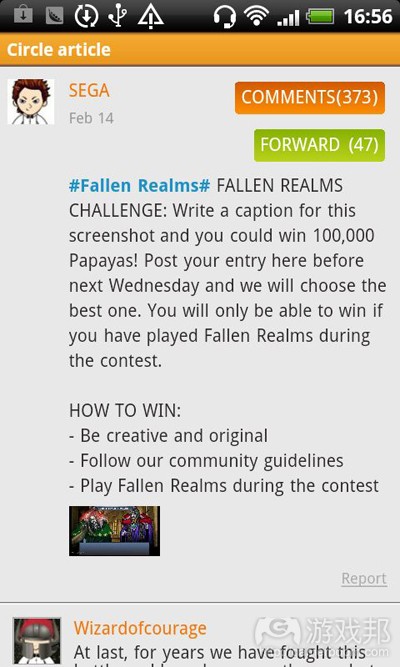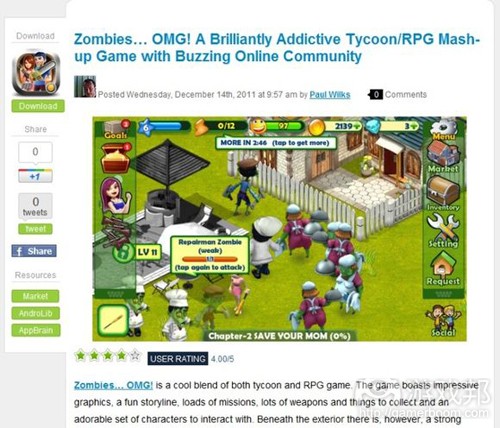分享跻身Google Play榜单前列的10大步骤
作者:Richard O’Connell
一般来说,投入上万美元去创造游戏也很难挤进Google Play应用商店(前身是Android Market)的10大热门游戏榜单中。特别是对于自主发行游戏的独立开发者来说,这更是一个极其艰巨的挑战。不过今天,我们将讨论如何不花什么钱就能将第一款Android游戏推向这一位置。
但是这并不是说较高的发行预算并不重要,相反地,如果拥有较多预算你便能够更容易获取用户,并更好地应对Google Play中愈演愈列的竞争环境。然而对于那些独立发行游戏的团队来说,能够把握住游戏的所有权并有利地面对大公司的竞争才更加重要。在木瓜移动,我们已经帮助很多大小公司在无需投入任何市场营销预算的前提下成功将游戏推向排行榜前列。
今天我将一步一步分析其中的步骤。
步骤1.正视最高榜单的价值
挤进这些最高排行榜对于你的游戏有何帮助?你必须理解最高榜单对于你的游戏的价值,因为这将影响你在游戏真正发行前所做出的任何决定。为了进入前20名你的游戏就需要获得每日至少1万5千的安装量,而前10名更更需要至少2万5千的安装量。通过奖励性广告网络而获得这些流量需要你每日支付至少2500美元的费用,而如果你选择采取非奖励性方式,你每天的费用甚至会高达1万美元。
1万5千的每日安装量换算成具体收益是多少?让我们假设你的游戏是一款拥有较高留存率的免费游戏,你每天通过虚拟产品能够获得0.10美元的ARPDAU,如果你的最小DAU是2万,那么你每天至少便能够获得2千美元的收益。努力提高你的DAU并维持玩家的用户粘性,你便能够拥有更多高消费玩家,你的游戏每天也将能够为你挣得更多收益。
2.理解Google Play排名算法
谷歌并没有公开Google Play的具体排名算法,所以尽管很多开发者在尝试着提升应用的排名,但是却仅有少量游戏能够真正出现在最高榜单的位置上。不过根据多年来的经验,我们也摸清了挤进Android Market最高排行榜所需要的一些重要元素。
发布时间-—–新应用在时间上拥有一定的优势。这种逻辑非常合理;因为玩家总是希望能够尝试新游戏。所以这对于新游戏来说是一种机会。你应该将这点视为Google Play排名算法之一,并测试你的游戏是否能够赢得玩家青睐。而同样地,如果你的应用在市场上发布1个多月后,它就很难再继续维持较高名次了。
用户留存率——虽然我仍然不是很清楚Google Play是如何计算这一标准,但我认为它很有可能是结合了活跃用户安装率以及用户粘性公式(游戏邦注:如DAU/MAU)。简单的说也就是高质量且有趣的游戏才能够获得较高排名!
用户评论-—–玩家对游戏的打分在某种程度上也是一种重要的影响元素,但是因为这些分数很容易被操纵,所以它对于游戏排名其实并没有那么大影响。不过这些分数仍然也是用户决定是否玩游戏的主要依据,因此对游戏的安装率也会产生影响。
每日安装率——提高游戏安装率将推动游戏排名的提升,并反过来能够继续提高安装率。这种能够自我维持的发展方式正是我们的追求。
3.每天监测应用排名情况
熟悉Google Play是如何设定游戏排名。App Annie(App Store分析和营销服务提供商)便提供了一个最佳解决方法,即可靠且容易理解的免费Android排行工具。你可以依此自己去理解排名算法的内涵,挑选一些最新发行的应用,并观察它们在更新或漏洞修改后的排行发生了何种改变。当你开始发行自己的游戏时,坚持每天监测排行情况,并记录下这些排名是否会随着游戏更新或漏洞修改而有所改变。同时你也需要记录下你的游戏性能参数是如何影响排行的变化。
4.社交性与免费模式
确保游戏具有社交性并实行免费模式能够降低游戏的准入障碍,让更多人能够轻松地玩游戏。让免费和付费玩家都能感受到游戏的乐趣。如果你提供给免费玩家有限的游戏内容,将进一步阻碍游戏安装率的提升,并最终不利益游戏排名上升。一款优秀的免费游戏可能会让5%至15%的玩家转变为付费玩家。但是这并不意味着非付费玩家就不再重要了。如果这些玩家喜欢你的游戏,他们虽然不能直接为你带来利益,但是却能够成为游戏的病毒式传播渠道。非付费玩家也是未来的潜在付费玩家,所以千万不要在他们面前设置过高的门槛,或者限制他们的游戏乐趣。你应该让免费玩家也能够完整地体验到游戏的乐趣,并让他们能够通过购买道具去提升自己游戏体验的价值,而不是只向他们开放部分游戏内容。
使用社交功能优化游戏玩法,并激励玩家表现出社交性。让游戏中的分享功能和社交功能能够利用异步玩法。优化游戏中的好友列表,挑战以及社交分享功能。世嘉发布于木瓜移动的《Fallen Realms》便是一款拥有有趣的社交玩法的游戏。在游戏中,当你获得好友时,你可以把他带到自己的团队中帮助对付地下城中的怪物,而你也可以帮助他们升级角色(即使你的好友并不在游戏中)。对于玩家来说,体验社交性也是有好处的!
5.展开内部测试
如果你在还未修改游戏中的重要漏洞之前便将其推向Google Play,你就很难从中获得真正收益。所以我们一定得忍住尽早发行游戏的冲动。带有各种漏洞的游戏很难在Google Play中获得较高的排名 。很多开发者都是在发布后才进行游戏测试,并希望游戏能够在两三个月后变得更加完美,但是这时候却真的太迟了。一款游戏在发布的第一个月,特别是第一周才有最大的机会跻身Google Play排行榜前列。而错失了这次机会你的游戏便很难再往上爬升了——即使在3个月后它变得非常有趣且非常完善。如果你真的错失了这一机会,唯一选择便是拥有足够的市场营销资金,努力提高游戏的ARPU。
换个说法,也就是如果先进行游戏的封闭性测试,你便能够发布一款完整,且经过优化的游戏,并且更加有可能发行的头几周便登上最高游戏排行榜单。
对于游戏测试,你需要明确设置用户数量限制。一般来说最多也就5千名注册用户。木瓜移动为开发者提供一批友好型用户帮助他们在发行游戏前进行测试。通过进行封闭性测试,你不仅能够为游戏做宣传,同时也能够促使测试者真正喜欢上你的游戏,并最终成为游戏的忠实玩家。
6.收集反馈并监测参数
向你的测试者征求反馈意见,收集这些反馈并获取用户手机操作系统版本以及设备型号。通过目标参数而非设置日期去决定游戏的发布时机。主要参数包括游戏的每日用户留存率,活跃用户安装率,K系数以及ARPDAU等数值。首先你需要找到那些阻碍游戏玩法并危害应用发展的主要漏洞。安装一些分析软件,如Flurry或Google Analytics去判断哪些设备更受欢迎,并确保你的游戏能够有效地运行于这些设备中。而因为Android游戏所面临设备型号多种多样,所以开发者如果想更好地应对激烈的竞争,就务必要在这个环节投入更多时间。
设定一种能够帮助收集用户反馈的系统——Android的市场评论便是一个好帮手,但是它却只允许一个用户作一次评论。手机信息留言板也能够帮助你有效地收集用户反馈信息(不只针对于测试阶段,也能够帮助你在今后更好地处理与用户间的交流)。
请求并核对测试者的反馈信息,以寻找你们团队所遗失的漏洞。如果你瞄准了20款最受欢迎的设备,你就相当于覆盖了一半的目标用户。接下来你便需要收集有关游戏玩法的反馈。密切关注着各种统计值,建立用户流以便明确哪些功能最有效,以及用户是因为哪些内容而退出游戏。了解用户喜欢什么以及不喜欢什么。设定AB分裂测试以衡量新功能的有效性,并保持这些功能的正常运行。测试不同价格策略并创造一种低价而易消耗的商品以及需要收取额外费用但却经久耐用的道具。当你对自己的游戏充满百分百的信心,保证游戏不再有漏洞,游戏玩法得到完善,用户留存参数也趋于稳定且ARPU值处于良好状态之时,你便可以发布游戏了。
7.发布新版本
确保你的新版本游戏拥有一个新的页面;这点非常重要,如此Google Play才可能完全将你的游戏当成一款新游戏,并赋予它初期攀登排行榜前列的机会。让你的测试者安装最新版本的游戏,并向他们保证之前在测试阶段所购买的道具都仍保存在自己的账号中。提供奖励道具以进一步激励玩家安装新版本游戏。这样不论是测试者还是后来加入游戏中的玩家都能够立刻推动游戏的发展。
8.优化Google Play图标,图像和文本
创造一个引人注目的图标,并确保你的用户能够在列表中一眼看到并点击这些图标。同时你还应该在你的游戏页面中呈现一副让人印象深刻的游戏图像。切记,在此的任何不专业表现都会影响用户对于应用的信任,并最终不利于游戏安装率的提升。Google Play对于应用的选择并不像苹果的App Store那般挑剔,而用户其实也都知道有些应用本身就具有较大的缺陷。所以我们千万不要给玩家留下任何不良印象。
对于游戏的描述,我们应该清楚地展现游戏的核心功能,并添加一些来自于玩家评论或评论网站中的正面评论。通过调查用户最常搜索的关键字而进行搜索引擎优化,并确保你的文本能够自然地包含这些内容。千万不要只是简单地罗列出这些关键字,因为这会显得平淡无味,并且也有可能吓跑一些玩家;而且谷歌也一直将“不要作恶”作为公司信条,所以你如果这么做将不利于游戏在该平台上的发展。谷歌关键字搜索工具实际上就等于在执行这一任务;尽管它并未包含Google Play本身的搜索结果,但是其搜索行为模式却与这一步骤无太大差别。
9.联系评论员和PR
罗列出一些可能对你的游戏感举起的应用/游戏网站。直接联系新闻记者,或者参加他们在Twitter,Facebook以及博客上举办的社交媒体活动。不要只是讲一下无关紧要的内容——而是应该展开一项有意义的讨论,从而为你同这些媒体的交流迈出第一步。提供一份包含图像,视频,描述,说明书以及包含游戏功能的简短攻略的媒体包,以帮助评论者能够更顺畅地尝试游戏。同时还应该提供给评论者一些免费的游戏内部货币让他们能够换取虚拟商品。
不要只是依赖于传统的游戏和应用网站,你同时也应该考虑那些目标用户可能会接触的博客等平台。就像如果你发布的是僵尸类游戏,就可以考虑联系那些宣传恐怖电影的网站。
10.植入手机社交游戏网站
当你的游戏得到完全的优化并成功发布后,你需要做的便是为游戏吸收一些稳定的用户。当你完成测试阶段并发行完整游戏后,你的游戏可能将拥有一部分老用户和新用户。依托一些手机社交网站,你可以免费获得这些网站的用户,从而快速推动游戏发展。
对于那些善于使用社交功能的有趣游戏,我们会在木瓜移动的游戏检索平台中进行推荐,并利用早前的一些游戏为其交叉推广,举办社区竞赛活动并向我们的大多数活跃用户发送pMail。
《Zombies…OMG!》是最近发布于木瓜移动平台的一款游戏,它是由一对夫妻共同制作的第一款Android游戏。他们没有足够的市场营销预算,但却希望自主发行游戏,所以他们投入了更多精力完善游戏及其社交机制。
当他们将pMail发送木瓜移动的大多数活跃用户后,该款游戏开始在Google Play排行榜中攀升,并在短短2周时间内就跻身休闲游戏榜单前十名。尽管未投入任何市场营销成本,只是利用木瓜移动现有的社交圈,社交游戏引擎以及相关工具,该游戏就在一个月内累积了超过50万次的安装量。
(本文为游戏邦/gamerboom.com编译,拒绝任何不保留版权的转载,如需转载请联系:游戏邦)
Sponsored Feature: 10 Steps for Top Google Play Store Rankings (Without Spending a Penny!)
by Richard O’Connell
It’s a commonly held myth that to attain high rankings in your category on Google’s Play Store (formerly Android Market) you need at least tens of thousands of dollars to have the slightest hope in hitting the top 10. For an indie developer self-publishing, it can seem a formidable challenge to reach those top spots. Let me assure you though — it’s possible to scale those charts without actually spending a penny on your first Android game.
That’s not to say that a large launch budget isn’t always necessary — you’ll certainly have an easier time acquiring users and the Play Store is becoming increasingly more competitive by the day. However for those teams wanting to go the self-published route, taking more ownership over their titles and having a good chance to compete against the big boys — there’s hope. At Papaya, we’ve worked with a range of different developers from the very large, to the very small and have successfully helped a number of them push their game into the lucrative top spots without actually spending anything on marketing.
Read on and I’ll explain the steps.
1. Keep your eye on the prize
What can reaching those top spots actually do for your game? It’s critical to understand the value a top rank will bring you for your game because this should affect your later decision-making when faced with pressures to launch a game before it’s actually ready. Expect at least 15,000 installs a day for making it to the top 20 of casual and at least 25,000 daily installs for making it top 10. Buying this traffic from an incentivized ad network would start from $2,500 per day. If you go the non-incentivized route, you’re looking closer to $10,000 minimum per day.
What should 15,000 daily installs equate to in revenue? Well assuming your game is freemium, with good retention rates and monetizes from virtual goods at a high ARPDAU of $0.10, then you should expect minimum DAUs of 20,000 and daily revenues of at least $2,000 per day. With hard work growing your DAUs and maintaining stickiness to create a high proportion of (high spending) true fans, your game could eventually be earning you tens of thousands of dollars, daily.
2. Understand the ranking algorithm.
The exact details of the ranking algorithm are a closely guarded secret and understandably so — there are thousands of developers all trying to rank their apps but a small, finite number of positions at the top. Even so, from experience we have an understanding of some factors that contribute to how a game ranks on the Android market.
Launch window – New apps tend to have an easier time ranking. The logic for this is sound. Users want to try new games. This gives new titles a chance. See this as the Play Store’s algorithm giving your game a little test to see if users actually like your game. Likewise, apps that have been on the market for more than month will find it very difficult to rank.
Retention – It’s still not entirely clear how Google Play calculates this but most likely a combination of active install rates and a stickiness formula such as DAU/MAU. In simple terms — high quality, fun games get high rankings!
User reviews – Scores count to some extent, but since these can be easily manipulated, their effect on ranking may be greatly overstated. Still — they’re essential for users to decide whether or not to play a game and will affect your install rate.
Daily number of installs – Driving installs will have the effect ranking your game higher which in turn gives you more installs. This self-sustaining spiral of growth is the goal and it’s how we’re going to get your app into those top spots.
3. Monitor app ranks daily
Get familiar with the way the Play Store ranks games. A great desktop solution is App Annie, whose free Android ranking tools are both reliable and comprehensive. To get a feel for the ranking algorithm yourself, pick some newly-launched apps and keep an eye on how their rankings change when the app is updated and fixes are made. When you’re ready to launch your own game, monitor its rankings daily and make note of how rankings change in line with your own updates and fixes. Also make note of how changes in your game’s performance metrics translate into ranking increases.
4. Make it social and freemium
Make your game social and freemium to create a low barrier to entry for anyone to play. Make it fun for free players as well as paying players. Simply providing a restricted, stripped down game for free players will lead to a higher uninstall rate which affects your rankings. A well-made freemium game should be able to convert around 5-15 percent of your users into paying users. This doesn’t make your non-paying users any less important to you though. If these users are enjoying your game, they may not contribute directly to your revenue, but they are potentially your most effective free viral marketing channel. Your non-paying players are also potential paying players of the future, so don’t put up too many walls that restrict gameplay or make their experience less fun. Allow them to enjoy the game and offer the opportunity to purchase items that add value to their experience, as opposed to simply unlocking vital parts of the gameplay.
Optimize your gameplay with social features and give your users incentives to be social. Enable sharing and social features that make use of asynchronous gameplay. Utilize friend lists, challenges and social sharing features for a high K factor. A great example of engaging social gameplay is in Sega’s Fallen Realms for Papaya. After you acquire friends, you bring them onto your team to assist slaying monsters in dungeons and you help level up their character – even when your friend isn’t playing. For gamers, it pays to be social!
SEGA’s Fallen Realms strikes a balance between social and gameplay and hardcore dungeon crawling elements.
5. Set up a closed Beta test
There’s often pressure to release a game onto the Play Store before major bugs are fixed, to start generating revenue immediately. Try to resist the temptation to release too early. A broken game on the Play Store is going to find it very tough to rank well at all. Developers often beta test with their users and hope that by the second or third month, their game will be almost perfect. The major downside to this launch strategy, is often by month two or three, it’s too late. Games have a small window of opportunity to easily rank on the android market — usually just the first month, with the first week being the most critical. Miss this window and it becomes increasingly more unlikely your game will naturally rank — even if by month three you have incredibly fun and polished game. If you get to this point, the only real option is to hope your game’s ARPU is high enough to warrant large investment into marketing.
If instead you start with a closed beta, you’ll have the opportunity to upload your final, polished, version to a separate listing and be more likely to scale the charts in the first few weeks of launch.
In a beta test, ensure you set a user limit. 5,000 registered users should be more than enough. At Papaya, we offer developers on our platform a pool of friendly users to beta test their game before live launch. By creating a closed beta test, you also build up hype and anticipation for your game, while making your beta testers feel especially loved and turning a good proportion of them into your top fans.
6. Collect feedback and monitor metrics
Ask for feedback from your beta testers and collect feedback, making sure you get user OS versions and handset models. Dictate your live launch, not by a set date, but by a goal for your metrics. Key metrics to follow closely are your daily retention rates, active install rate, K factor, and ARPDAU. Clearing major bugs that hinder gameplay or crash the app should be the first priority. Install app analytics such as Flurry or even Google Analytics to monitor which handsets are most popular and get your game working flawlessly on those devices. Android games tend to have a large long tail of handsets, so this part can be time consuming but is essential if you want to inch ahead of your competitors.
Set up systems to collect user feedback. Android market comments are a good place to start, but they only allow for one comment per user. A mobile message board for users to post feedback is really effective, not just in the beta period but also for longer-term communications too. Papaya SDKs come with ready-made message boards for nurturing a community.
A community message board where users share tips and win in-game prizes
Request and check beta tester feedback to find bugs that your team misses. If you focus on the top 20 handsets, you should cover about 50 percent. Your next priority should be on collecting gameplay feedback. Monitor your stats closely and set up user flows so you can see which features are most effective and where users are dropping off. Collect feedback from your users on what they like and what they don’t. Set up split AB tests to measure effectiveness of new features, and keep those that perform best. Experiment with different pricing strategies and create a good mix of low cost consumables and premium durable items. Once you’re confident your game is largely bug-free, gameplay is polished, retention metrics are solid, and ARPUs are great — it’s time to launch.
7. Launch with a new Play Market listing
Make sure you have a fresh new page for your live version of the game. This is essential, so the Play Store treats your game as a completely new title, allowing it to hit that early window of opportunity for high rankings. Insist that your beta testers install the new live version of the game, but assure them their accounts will still contain their progress and any items they already purchased during the beta test period. Offer a bonus item as a further incentive for installing the new version. The influx of beta testers combined with all those users who are now suddenly able to access the game should give your live version an immediate boost.
8. Polish and optimize your Google Play icons, artwork and text
Make sure you have an eye-catching icon that gives users a reason to click through to your listing. Once on your game’s page, make sure you have an impressive lead game image. Amateurish attempts here can really affect whether a user will trust to download your app and can lead to lower install rate. Remember, Google’s Play Store is not so picky about its apps compared to Apple’s App Store and users are well aware that some apps may be malicious in nature. Don’t give users any reason to doubt your game.
For your game description, clearly list your core features and add some examples of positive reviews, either from the comments or from review websites. Do SEO optimization by researching keywords that users are searching with and make sure your text naturally incorporates them into the text. Don’t simply list your keywords — it looks spammy, could frighten some users away, and since the Play Store is run by the “Don’t be Evil” gods of search themselves, you could end up with a suspended app. Google’s keyword research tool is as good as ever for this task. Although it doesn’t incorporate Google Play search results per se, the search behavior patterns should be similar enough for this step.
9. Ready reviews and PR for launch
Create a list of app and gaming websites you know are going to love your app. Contact the journalists, either directly, or first taking part in their own social media activates on Twitter, Facebook, and blogs. Don’t be spammy — just contribute meaningful discussion and you will have a good starting point for making contact. Provide a media pack that includes artwork, videos, descriptions, a fact sheet, and even a short walkthrough that shows off interesting features the reviewer should take note of when playing the game. You could also offer the reviewer some free in-game currency to try virtual goods.
Zombies…OMG! Reviewed in time for launch.
Don’t just stick to the typical gaming and app websites — also think about the other kinds of blogs your target user might also be reading. Have a Zombie game? Why not try contacting websites devoted to horror movies?
10. Combine a push from a social gaming network for mobiles
With your game fully optimized and launched, an injection of sticky users is all you really need to start the self-sustaining spiral of growth after launch. After your beta period has finished and you’ve launched the live version, the game will already have an influx of old users and new users waiting to play. Readying some support from a mobile social network for a free push to their own users can give your game a significant boost. A number of social gaming networks exist, but I’ll focus on what Papaya can do.
Zombies…OMG! developed by a husband and wife team of two.
For fun games that make good use of social features, we’ll push them to our user base. We’ll feature it on our game discovery platform, cross promote it with our own games, hold community contests and send pMails to millions of our most active users. Papaya’s userbase is sticky enough to send games that are thoroughly optimized and beta tested to the top of the Play Store rankings.
Zombies…OMG! Was a recently-launched title on Papaya built by a husband and wife team of two making their first-ever Android title. They had no budget for marketing but wanted to self-publish, so they ensured their game was extremely well polished and optimized with a great array of engaging social gameplay mechanics.
After distributing a pMail to Papaya’s most active users, the game started its ascent on the Play Store, making it into the top 10 of casual within 2 weeks of launch. Within a month their first title had amassed more than half a million installs, having not spent a penny on marketing and just making use of Papaya’s existing social graph, Social Game Engine and social gameplay tools.(source:GAMASUTRA)











































 闽公网安备35020302001549号
闽公网安备35020302001549号